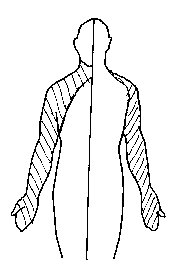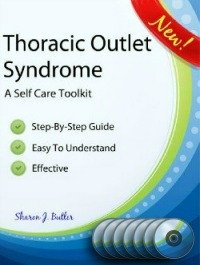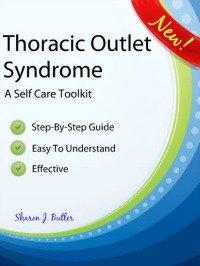Thoracic Outlet Syndrome
Thoracic Outlet Syndrome (TOS) causes problems with sensation, range of motion, strength and circulation of the hand and arm.
In TOS, the muscles and bones have often shifted position primarily due to restricted fascia. When the restrictions happen in the area around the scalene muscles at the sides of the neck, around the collarbone, or the front of the upper chest, the brachial plexus bundle of nerves can get pinched, crushed, or irritated. This can lead to numb hands and arms, pain and limited range of motion in your upper body.
Because the arteries and veins that serve the arm and hand pass right alongside the brachial plexus of nerves, circulation can be compromised as well. Some of the most common and troubling symptoms include swelling, cold and painful arms and hands.
Areas Of The Upper Body Affected By TOS

The brachial plexus, the main nerve bundle that passes through the thoracic outlet originates between the neck vertebrae, travels between the scalene muscles, passes between the collarbone and the first rib and then under the pectoralis minor muscle at the front of the shoulder in the upper chest. These three locations are the primary sites of Thoracic Outlet Syndrome.
A sufferer can experience problems in one, two, or all three areas. When the brachial plexus is impinged in any of the three areas, sensation is lost to the arm and hand. Not only will there be numbness, but there can also be weakness, aching, pain, and loss of coordination.
The subclavian artery and vein travel through the thoracic outlet alongside the brachial plexus and they can also be impinged by tight and restricted fascia in the same regions of the body. When the circulation they bring to the arm and hand are restricted, the limb can turn white or blue and cold in addition to all the numbness. This is a very troubling condition!

Click HERE to Learn More
How Do I Recover From TOS?
I won't sugar coat this. Recovering from Thoracic Outlet Syndrome is not an easy task. But it is possible to do if you educate yourself about the condition, how your body has changed leading to your symptoms, and you discover what works and what doesn't work for your body.
Of course, realizing early that you have a problem developing in your body is the best time to start any kind of recovery program. But we humans tend to ignore symptoms until they are screaming at us and by that time, the condition that is causing our pain has had the time to become more complex and more deeply entrenched in our bodies.
Read more about how to recover from TOS HERE.
Fascia And TOS
Fascia is found in all areas of the thoracic outlet. It is fascia's quality of adapting to stress that can lead to the symptoms of TOS.
By way of structural stresses like poor posture, chronic holding patterns, and the results of accidents and injuries, the fascia undergoes a chemical change, becoming more restricted and sticky. Over time, all the structures that are normally supposed to slide and glide across one another begin to stick together, limiting normal movement and causing impingement of the nerves and blood vessels.
If these changes happen to affect the brachial plexus or the subclavian artery or vein, then TOS is the likely outcome.
”Just wanted to drop you a quick note...have faithfully done the stretches two or three times a day, since I got your course eight days ago. I HAVE BEEN PAIN FREE FOR EIGHT DAYS...ABSOLUTELY AMAZING. I have made huge progress with your TOS program. I am functional...can lift weights, sleep through night, eliminated 95% of shoulder/neck issues...100% with diligence on stretches. I actively lift weights three times a week and do interval treadmill work three times a week. I can lift coffee cups and turn door knobs again..yeah! This has been a huge blessing, because I have tried three other courses, exercise programs, acupuncture, chiropractic..and this one is the only one that stops the pain."
- B. Birthisel
Now Available!

Click HERE to learn more about the Thoracic Outlet Syndrome Self Care Toolkit and how it can help you enjoy a safe and rapid recovery.
You can learn more about the specific elements of TOS and how they affect one another by visiting the following links:
